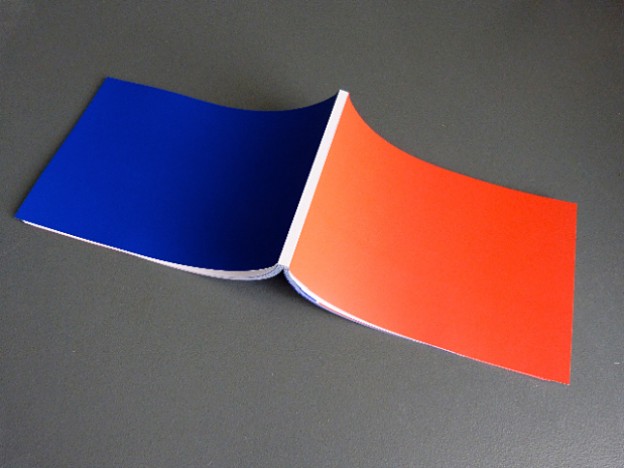Artist book published by éditions Incertain Sens & CAC Brétigny, 2013.
This book represents the results of 50 surveys carried out since the beginning of the 21st century on both economic and political and social and cultural issues by the main French opinion poll organisations (BVA, CSA, IFOP, TNS Sofres, etc.). The percentages of the answers given to each question reconfigure the width of the different bands of colour in the French flag, which retains its official overall proportions (2:3). Answers that correspond to the first part of an answer, or “yes”, go to making up the blue section of the flag; answers that correspond to the second part of an answer, or “no”, go to making up the red section; in the middle, unanswered questions (undecided) go to making up the white section. The composition of colours generated for the question posed therefore distorts the French Republican emblem according to “public opinion”. In the Wikipedia entry for the “French flag”, it says that for a long time the three bands of colour weren’t the same width (this is the case for the flag for Paris and this practise continued during the revolution). It is only since Napoleon Bonaparte, on the advice of the painter Jacques-Louis David, that the regulation was established instituting bands of colour of equal width. The use of statistics to predict the future also became more commonplace in the 18th century, with the opinion poll – in which “the whole can be represented by a proportion of the whole” – becoming associated with the idea of representativity. One of the paradoxes of these surveys, which is all the more apparent today as they now seem to cover even the minutest aspects of social life, is that they both aim to give public opinion, which is presented as the “truth of the people” – but which, in terms of its expression, if not its calculation, remains subject to caution –, and tend, to borrow the words of French philosopher Jacques Bouveresse, in terms of the very principle of the statistics of which they are composed, to make “individuals, ideas and events almost entirely interchangeable”.
Livre d’artiste publié par les éditions Incertain Sens et le CAC Brétigny, 2013.
Ce livre reprend 50 sondages réalisés depuis le début du XXIe siècle par les principaux instituts de sondage français (BVA, CSA, IFOP, TNS Sofres, etc.), touchant aussi bien à des questions économiques et politiques que sociales et culturelles. Les pourcentages des réponses données à chaque question reconfigurent la largeur des bandes du drapeau français, en conservant toutefois ses couleurs et ses proportions (2:3) officielles. Le premier élément de réponse ou la réponse « oui » correspond à la couleur bleue ; le deuxième élément de réponse ou la réponse « non » à la couleur rouge ; au milieu, la part des sans réponses (ne se prononcent pas) équivaut au blanc. La composition de couleurs ainsi générée fait face à la question posée, distordant au gré de l’« opinion publique » cet emblème de la République française. À l’entrée « drapeau de la France » dans Wikipédia, on peut lire que pendant longtemps, les trois bandes n’avaient pas la même largeur (c’est le cas du drapeau de Paris et cet usage s’est conservé durant la révolution). Il apparaît que c’est seulement depuis Napoléon Bonaparte et sur les conseils du peintre Jacques-Louis David que la réglementation instituant des bandes de largeur égale a été établie. C’est également au XVIIIe siècle que le rôle prévisionnel des statistiques se met en place, le sondage – où « la partie peut remplacer le tout » – devenant à leur suite associé à l’idée de représentativité. L’un des paradoxes de ces sondages, d’autant plus manifeste aujourd’hui que le moindre aspect de la vie sociale ne semble pouvoir leur échapper, est qu’à la fois ils entendent livrer une opinion publique faisant office de « vérité du peuple » – qui pourtant dans son expression, sinon son calcul, reste sujette à caution –, et que dans le principe même de leurs statistiques, ils tendent à rendre, pour reprendre les mots de Jacques Bouveresse, « les individus, les idées et les événements presque complètement interchangeables ».
